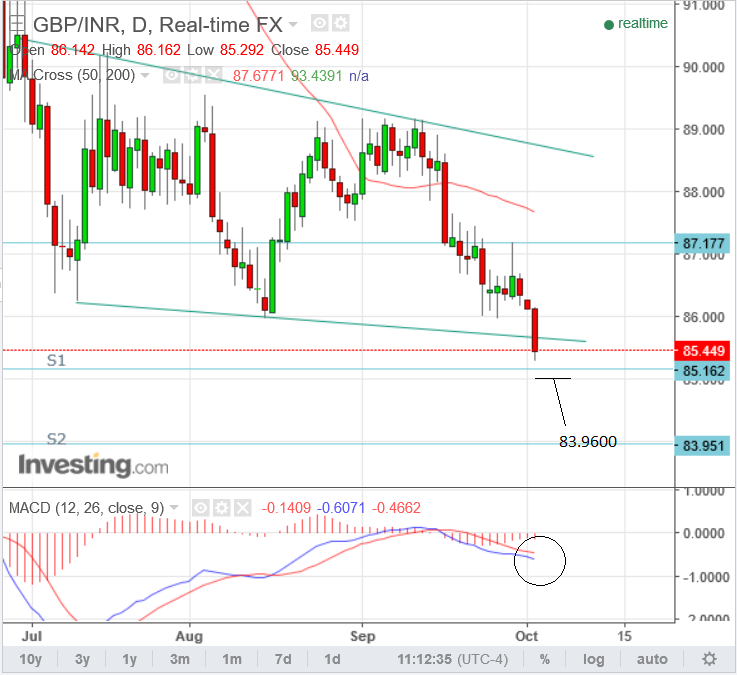Indian Rupee Advances on Pound Despite Reserve Bank of India Rate Cut

The Rupee continued to rise against the pound on Tuesday even after the Reserve Bank of India (RBI) decided to cut interest rates, a move which would normally be expected to weaken the Rupee.
The GBP/INR pair broke below key support at the start of the trading week after a speech by UK Prime Minister Theresa May over the weekend set a deadline for the start of the legal process of leaving the European Union (EU) and announced the repeal of EU laws governing the UK.
The pair then continued its slide on Tuesday following the announcement from the RBI that it was cutting the Indian base interest rate to 6.25% from 6.5% previously
Such a move would normally be expected to have the opposite effect – that is of weakening the rupee, not the pound, however, on this occasion this was not the case, as Brexit woes trumped all other considerations.
The RBI said a lower inflation outlook was one major reason for the rate cut, since the monsoon rains had been generous this year leading to heightened expectations of a positive harvest and a food surplus.
Food is one of the major factors driving up inflation so a positive harvest would be expected to slow that inflation down.
Recent CPI showed Indian inflation already falling to only 5.05% - quite a low figure – and this may have been further reason for the RBI cutting rates.
Regardless of the reasons the effect was limited on the GBP/INR pair which continued pushing down to new lows.
Hard Brexit Fears Dominate
The setting of an unambiguous timeline for the divorce sent Sterling into a tailspin at the week’s open, as it focused minds on the reality of a full Brexit and the possible negative impact on business.
News during the week from Switzerland had inferred a tough stance by the EU in relation to the principle of freedom of movement.
The EU did not back down in negotiations with Switzerland which had wanted to limit immigration whilst remaining in the common market, the EU trading club.
This led to the Swiss having to hold another referendum to decide whether to choose to remain in the common market or control its immigration. In the end, the people voted to stay.
Concerns are that if the UK leaves the common market the city of London will lose its status as the financial capital of the world and that many other businesses which conduct trade with the continent could suffer, as well as foreign investment.
This came to head on Monday weakening the pound in most pairs including versus the Indian Rupee.
The rupee itself was supported by a continued positive outlook for the economy which is still the fastest growing in the world at 7.1%.
The currency is further supported by an expected narrowing of the Current Account deficit over the next few months, which is forecast to narrow to 0.7% of GDP, from the current 1.5%.
Although the Reserve Bank of India (RBI) is expected to intervene to keep the Rupee weak, in order to encourage exports, the 'tide' will be supportive of INR strength rather than weakness.
The strong Indian stock market, which saw the Sensex rise over 300 points on Friday, due to easing global concerns about Deutsche Bank, as well as the improved outlook for the Indian economy also supports portfolio inflows from overseas investors favouring Indian assets.
Finally, the RBI, which is about to finish its monetary policy meeting (October 4) is seen as hawkish overall (hawkish = preferring higher interest rates) and this is likely to further keep the currency strong as they are unlikely to cut interest rates.
Technical Outlook for GBP/INR
From a technical POV the GBP/INR chart currently looks extremely bearish as the exchange rate breaks down through the bottom of down-sloping consolidation pattern.
This may indicate a breakout from the pattern, and a move of at least 61.8% of the height of the range lower, indicating an end target of 83.9600.
Support at 85.1600, not far below the current level and the base of the down slanting consolidation also needs to be breached before confirmation continuation lower can be confirmed.
This would require a move below 85.0000 for confirmation, with a downside target at 83.9600.
Expectations of more bearishness are heightened by the MACD momentum indicator, which has tipped below the zero-line, and the longer-term charts which show a bearish double top pattern on the monthly chart.





